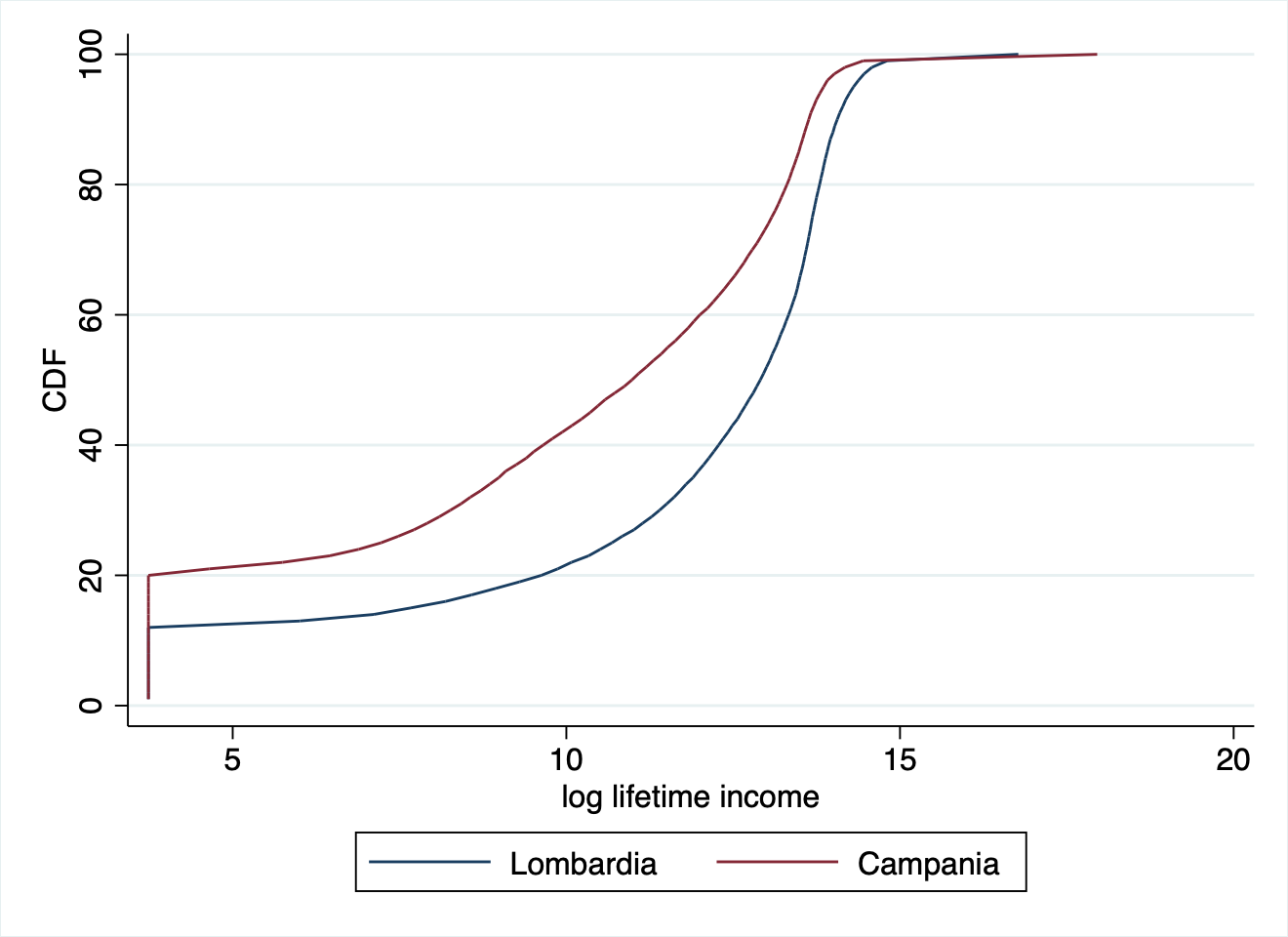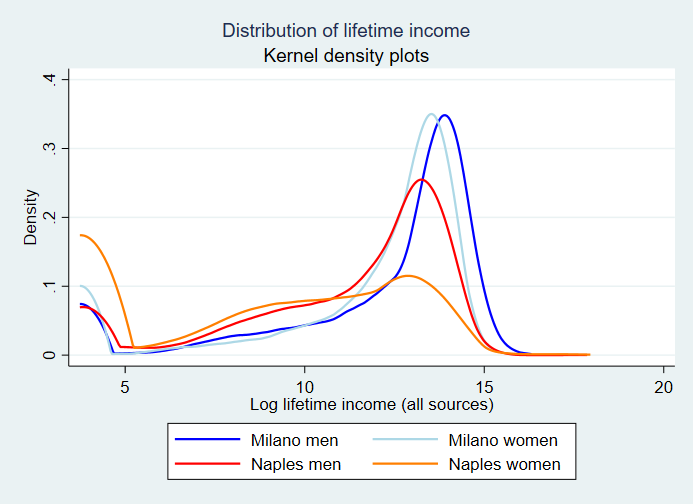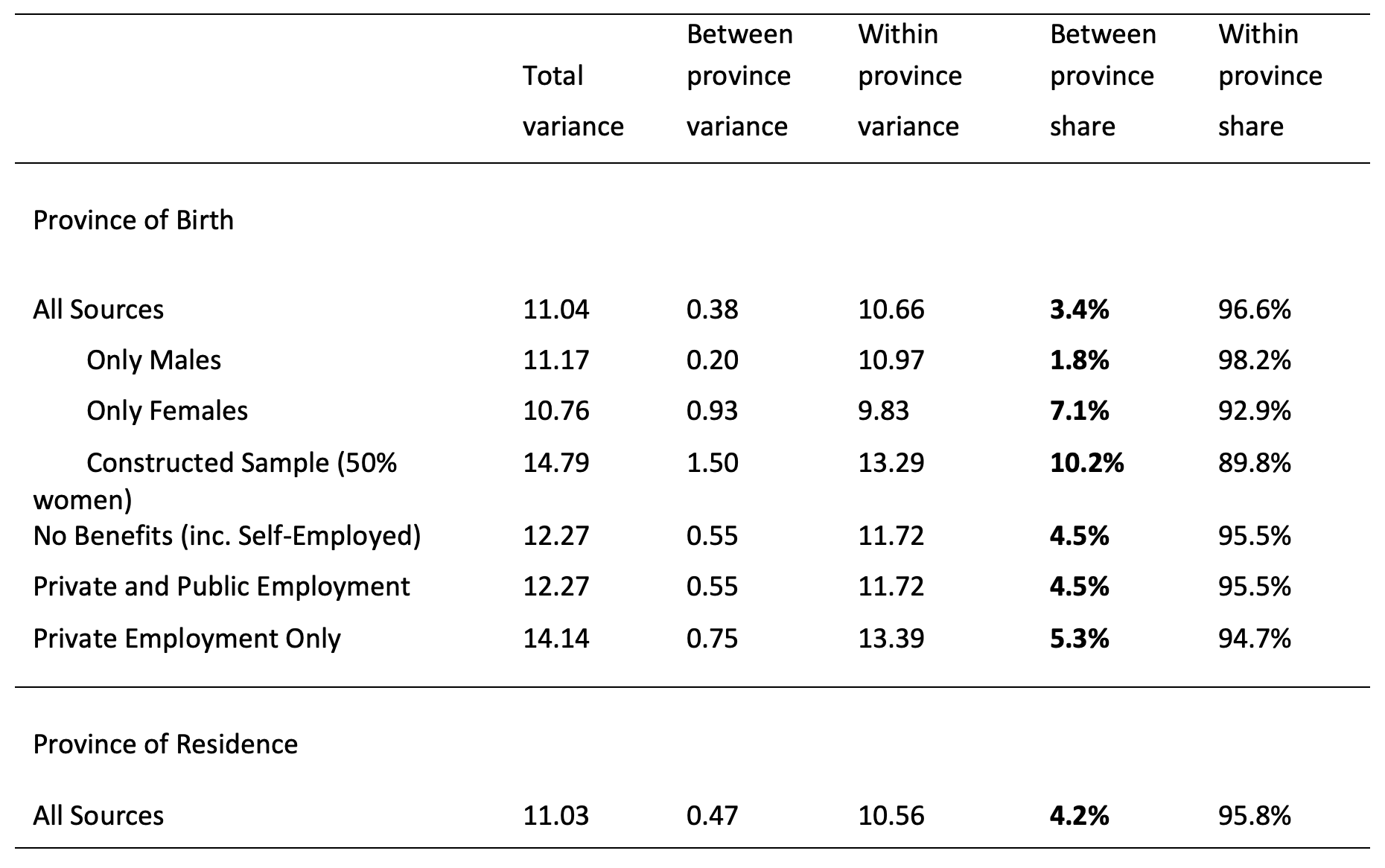If there is a country that is stereotypical of regional inequality, it is Italy. The relatively late unification of the country and the complex history of the peninsula have created a well-known narrative about the prosperous North and the pauper South. And it is true that the average income in the North is substantially higher than in the South (Barone and de Blasio 2023). In our data, the richest province has average annual earnings almost two and half times higher than the poorest province, and the average wage rate is about 47% higher (Briskar et al. 2022b). Consequently, one could think that place of birth is an important determinant of the income of Italians and, as a result, that those born in provinces with higher average incomes play the lottery of life with better cards than those born in the southern provinces. We show that this is not the case. The North-South divide plays only a marginal role in determining inequality between Italians.
We focus on lifetime income, a good proxy for wellbeing, for the cohort born in 1960. This measure captures differences between individuals in labour supply as well as in rates of pay over the working life. Our results will pick up differences in both wages and employment rates between locations. We assign every individual to his province of birth, but it is interesting to remark that assigning individuals to province of residence does not change results qualitatively, indicating that migration is not driving our findings.
Yes, the North is richer (in Figure 1 we even show that the distribution of lifetime income in the North first order stochastically dominates that of the South). Still, the difference in average income between the rich and poor provinces is much smaller than the differences between individuals who live in any given province, as can be seen in Figure 2. That is, even though the North is richer on average, there are many very rich people in the South and many very poor people in the North.
Figure 1 Cumulative distribution of lifetime income in Lombardy and Campania for individuals born in 1960, showing that the distribution in Lombardy first order stochastically dominates the one in Campania
Note: Lifetime Income is defined as the summation of all income from 1975 to 2016, adjusted by CPI.
Figure 2 Kernel density of lifetime incomes in Milano and Naples for both males and females (1960 cohort)
Note: Notice that the dispersion within any group is vastly larger than the dispersion of the average of the groups.
To be more specific, we decompose the variance of log lifetime income in the between-province and within-province components (Table 1), which is equivalent to running a regression of lifetime income on provincial dummies. It is apparent that knowing the province of birth (or residence) of a person is close to useless for determining his or her income.
Table 1 Decomposition of variance of (log) lifetime income
Note: In the Constructed Sample, the number of females is artificially increased to be equal to the number of males in every province of birth.
Province of birth explains 3.4% of the variance of lifetime income, while the last province of work (accounting for migration) accounts for just 4.2% of the total variance. This also holds for different definitions of lifetime income in terms of sources of income: private and public sector employment, self-employment, and benefits. Moreover, the reverse is also true. If you aim to guess the province where a certain Italian was born (or resides), then knowing his or her lifetime income is not informative.
This result may be surprising, but it is by no means obvious. Other salient characteristics of an individual, like education, gender, or sector of activity help to predict income to a much better degree than geography. In a companion paper (Briskar et al. 2022b) we show that just a two-digit industry classification (and there are 88 of them, compared to around 110 provinces) can on its own explain 25% of the variance of log annual earnings in 2018. This is in line with Brunello et al. (2012), who show that industry explains approximately 25% of differences in wages, while education explains approximately 16% of differences in wages and 20% of differences in lifetime earnings. In contrast, geography accounts for a mere 1.8% of the variance of lifetime income of men. Education, gender, and sector of activity are much more important drivers of inequality, yet the discussion of inequality in (and about) Italy is dramatically fixated on geographical differences.
The fact that the North-South divide is only a minor driver of inequality in Italy has an important qualification. For women, there are very large differences in participation that can be attributed to the province of birth. These differences in participation between provinces translate to differences in female average income between provinces that explain a much larger share of the inequality between Italian women. Province of birth explains 7.1% of lifetime income inequality among women. However, this is an underestimate given that some women never work and so do not appear in social security records. Interestingly, economically inactive individuals are not uniformly distributed, neither across Italy nor across genders. The percentage of males in our data is larger in the southern provinces and correlates negatively with the average lifetime income of the province (point correlation of −0.48). To account for this phenomenon, we manually add “artificial” females to our data, so that in each province of birth we have a balanced sample of men and women, i.e. 50% men and 50% women. For men (of course) nothing changes, but for women, the role of geography increases: the between-province share of the total variance rises to 10.2%.
Notice also that while we show that province of birth or residence plays only a very small role in accounting for differences in lifetime income between Italians, other aspects of geography – such as living in an urban or a rural area or the specific neighbourhood that a person grows up in – might be more salient. These factors are most likely important for understanding inequality and its dynamics, but they are beyond the focus of our study, and independent of the North-South debate.
Thus, the overall picture is that even though it is better to be born in Northern provinces, it does not amount to a huge thing in the context of the wide lottery of life. The inequalities within provinces dwarf any differences between provinces. Children born in rich families in the South (and there are many of them) face life with much better cards than those born in poor families in the North. It is this inequality (between poor and rich individuals) that is the true source of differences between Italians. So much so that if the differences between provinces were to disappear, the differences between Italians would almost not change at all. The reduction of regional disparities may be very beneficial for many reasons, but it is essentially ineffectual in reducing inequality between Italians.
Authors' note: The data used in this column are provided by the VisitINPS scholar project.
References
Barone, G and G de Blasio (2023), “Place-based policies in the Italian case, part 1: A lot of money for little or no growth”, VoxEU.org, 31 January.
Briskar, J, E D Porto, J R Mora and C Tealdi (2022a), “The Role of Geography in Determining the Inequality between Italians”, CEPR Discussion Paper 18224.
Briskar, J, E D Porto, J R Mora and C Tealdi (2022b), “Decomposition of Italian inequality”, WorkINPS Working Paper No. 53.
Brunello, G, G Weber and C Weiss (2012), “Books are forever: Early life conditions, education and lifetime income”, IZA Discussion Papers 6386.










